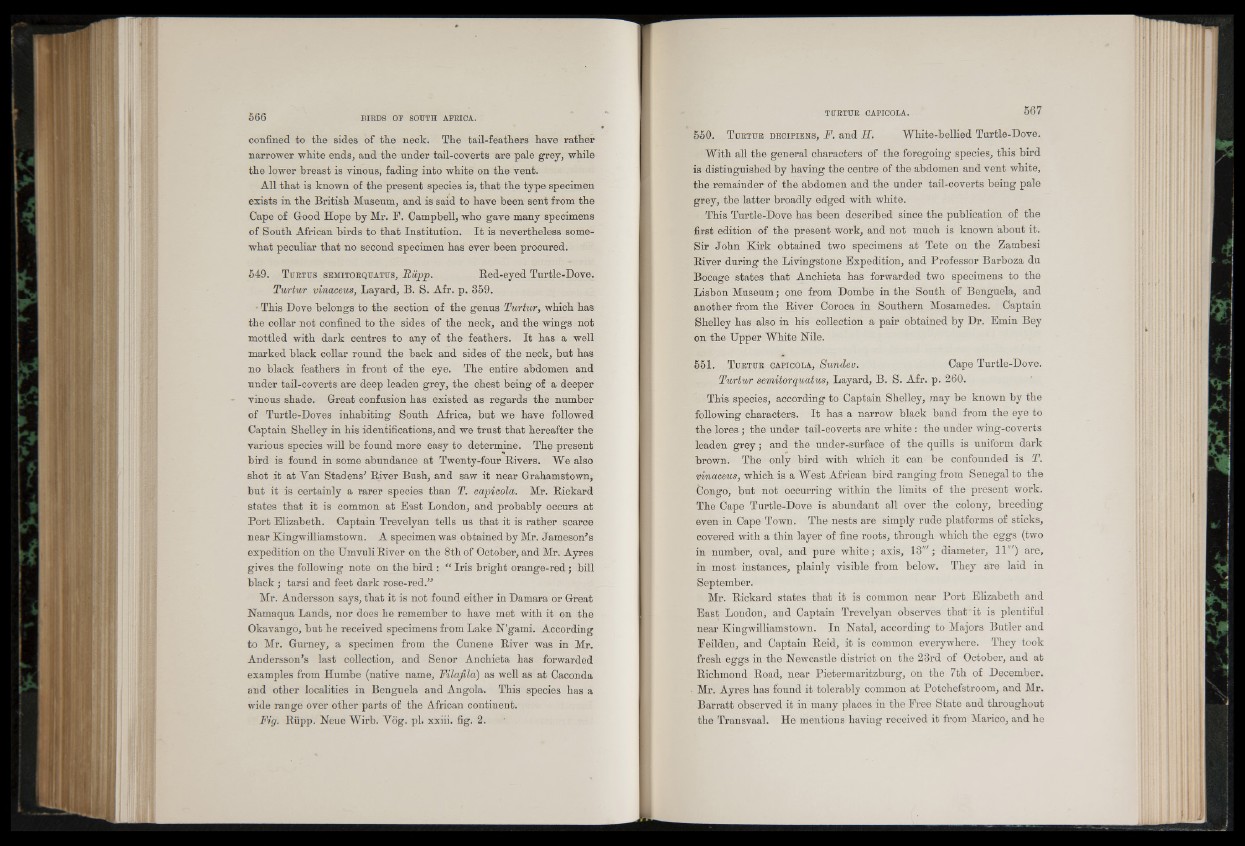
confined to the sides of the neck. The tail-feathers have rather
narrower white ends, and the under tail-coverts are pale grey, while
the lower breast is vinous, fading into white on the vent.
All that is known of the present species is, that the type specimen
exists in the British Museum, and is said to have been sent from the
Cape of Good Hope by Mr. P. Campbell, who gave many specimens
of South African birds to that Institution. I t is nevertheless somewhat
peculiar that no second specimen has ever been procured.
5 4 9 . T urtus semitorquatus, Rupp. Red-eyed Turtle-Dove.
Turtur vinaceus, Layard, B. S. Afr. p. 359.
■ This Dove belongs to the section of the genus Turtur, which has
the collar not confined to the sides of the neck, and the wings not
mottled with dark centres to any of the feathers. It has a well
marked black collar round the back and sides of the neck, but has
no black feathers in front of the eye. The entire abdomen and
under tail-coverts are deep leaden grey, the chest being of a deeper
vinous shade. Great confusion has existed as regards the number
of Turtle-Doves inhabiting South Africa, but we have followed
Captain Shelley in his identifications, and we trust that hereafter the
various species will be found more easy to determine. The present
bird is found in some abundance at Twenty-four Rivers. We also
shot it at Van Stadens' River Bush, and saw it near Grahamstown,
but it is certainly a rarer species than T. capicola. Mr. Rickard
states that it is common at East London, and probably occurs at
Port Elizabeth. Captain Trevelyan tells us that it is rather scarce
near Kingwilliamstown. A specimen was obtained by Mr. Jameson's
expedition on the Umvuli River on the 8th of October, and Mr. Ayres
gives the following note on the bird : “ Iris bright orange-red; bill
black ; tarsi and feet dark rose-red.”
Mr. Andersson says, that it is not found either in Damara or Great
Namaqua Lands, nor does he remember to have met with it on the
Okavango, but he received specimens from Lake N’gami. According
to Mr. Gurney, a specimen from the Cunene River was in Mr.
Andersson’s last collection, and Senor Anchieta has forwarded
examples from Humbe (native name, Filajila) as well as at Caconda
and other localities in Benguela and Angola. This species has a
wide range over other parts of the African continent.
Fig. Rupp. Neue Wirb. Yog. pi. xxiii. fig. 2.
5 5 0 . T u r t u r d e c i p i e n s , F. and H. White-bellied Turtle-Dove.
With all the general characters of the foregoing species, this bird
is distinguished by having the centre of the abdomen and vent white,
the remainder of the abdomen and the under tail-coverts being pale
grey, the latter broadly edged with white.
This Turtle-Dove has been described since the publication of the
first edition of the present work, and not much is known about it.
Sir John Kirk obtained two specimens at Tete on the Zambesi
River during the Livingstone Expedition, and Professor Barboza du
Bocage states that Anchieta has forwarded two specimens to the
Lisbon Museum; one from Dombe in the South of Benguela, and
another from the River Ooroca in Southern Mosamedes. Captain
Shelley has also in his collection a pair obtained by Dr. Emin Bey
on the Upper White Nile.
5 5 1 . T u r t u r c a p i c o l a , Sundev. Cape Turtle-Dove.
Turtur semitorquatus, Layard, B. S. Afr. p. 260.
This species, according to Captain Shelley, may be known by the
following characters. It has a narrow black band from the eye to
the lores; the under tail-coverts are white : the under wing-coverts
leaden grey; and the under-surface of the quills is uniform dark
brown. The only bird with which it can be confounded is T.
vinaceus, which is a West African bird ranging from Senegal to the
Congo, but not occurring within the limits of the present work.
The Cape Turtle-Dove is abundant all over the colony, breeding
even in Cape Town. The nests are simply rude platforms of sticks,
covered with a thin layer of fine roots, through which the eggs (two
in number, oval, and pure white; axis, 13'"; diameter, 11"') are,
in most instances, plainly visible from below. They are laid in
September.
Mr. Rickard states that it is common near Port Elizabeth and
East London, and Captain Trevelyan observes that it is plentiful
near Kingwilliamstown. In Natal, according to Majors Butler and
Feilden, and Captain Reid, it is common everywhere. They took
fresh eggs in the Newcastle district on the 23rd of October, and at
Richmond Road, near Pietermaritzburg, on the 7th of December.
Mr. Ayres has found it tolerably common at Potchefstroom, and Mr.
Barratt observed it in many places in the Free State and throughout
the Transvaal. He mentions having received it from Marico, and he